Seitenpfad:
- Paleo-Biogeochemistry
- Research
Research Topics

Statement and goals
Funded by the Max Planck Society (MPG), the German Research Foundation (DFG) and the Agouron Institute, we aim at understanding what drove the evolution of increasingly complex life on Earth. Using techniques of molecular organic geochemistry, isotope geochemistry and paleobiology we principally focus on the co-evolution of environmental conditions and organismic diversity during the Precambrian and earliest Paleozoic. We try to understand when, where and why the first eukaryotes and the first metazoa appeared, and how this reciprocally influenced environmental oxygenation, climate, as well as carbon and nutrient cycling.
Active projects
Earth's earliest biosphere
The earliest clues about the nature of life used to come from hopane and sterane biomarkers found in Archean (2.5–2.8 Ga) rocks. But during an ultra-clean drilling campaign (AIDP 2012) we were able to show that the studied rock sequences are overmature and only contain non-indigenous contaminants. This study showed that big questions require big approaches. We continue searching for the oldest molecular remnant of life and are still studying Archean environmental conditions using indigenous (but biologically non-diagnostic) hydrocarbons. In 2016 a new ultra-clean drilling campaign was succesfully conducted in South Africa—stay tuned for updates.
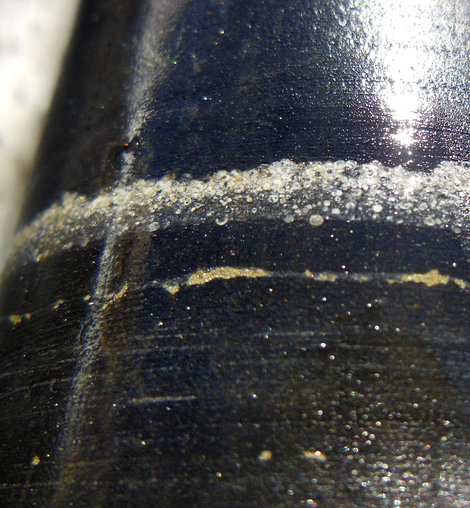
Collaborators:
- Nic Beukes (Uni Johannesburg)
- Dawn Sumner (UC Davis)
- Woodward Fischer (CalTech)
- Roger Summons (MIT)
A white layer of impact spherules within black shales of the Marra Mamba Iron Fm (here in drill hole AIDP-3) serves as a chronostratigraphic marker horizon in Neoarchean sequences of the Pilbara Craton.

Neoproterozoic radiation of algae and metazoa
The discovery that eukaryotic steranes in Archean rocks are not syngenetic made much sense in the framework of other findings—molecular clocks place the origin of the eukaryotic lineage around 1.8 Ga, while the oldest unambiguously eukaryotic microfossils date to ca. 1.6 Ga. An early Neoproterozoic diversification of early protists is evident from the microfossil record, but one significant question is: when did eukaryotes become ecologically relevant?
Collaborators:
- Jochen Brocks (ANU)
- Paul Strother (Boston College)
- Malgorzata Modczydlowska (Uppsala University)
aov owieg o won rg rrergtrb
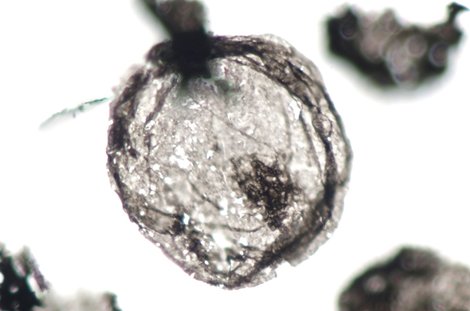

Precambrian redox evolution & carbon cycling
The Neoproterozoic Era witnessed frequent and intense perturbations of the marine carbon cycle, as recorded in sedimentary 13C anomalies of a magnitude, frequency and duration that sets them apart from such fluctuations during the Phanerozoic. Given the absence of a solid biostratigraphic framework, these anomalies have been frequently used for chemostratigraphic purposes. Yet the problem here is that we still often lack a thorough mechanistic understanding of the underlying drivers. Apart from bulk 13C anomalies recorded in carbonates and associated kerogens, Neoproterozoic carbon isotope anomalies are also evident on a molecular level. We study different potential influences on anomalous carbon isotope behaviour and try to understand the Neoproterozoic carbon cycle in the context of redox evolution and sequence stratigraphy.
Collaborators:
- Pierre Sansjofre (Uni Brest)
- Enno Schefuss (MARUM)
- Jochen Brocks (ANU)

Lipid biosynthesis
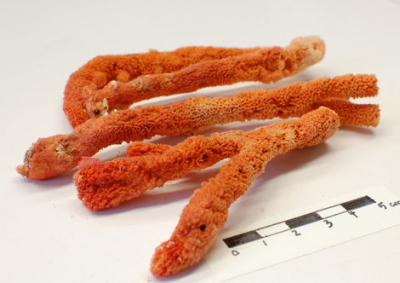
Axinella sp.
To gain a better understanding of what the molecular biomarker signatures that we find in ancient rocks actually mean, we study the capacity of lipid biosynthesis in a range of modern marine organisms. Not only can existing biological markers lose their diagnosticity, such as in the case of 2-methylhopanes that turned out to be produced by many bacteria outside of the cyanobacteria, but novel markers can be found. By delving into the genetic basis of lipid biosynthesis (where possible) and performing culturing studies, we try to clarify the utility of certain molecular markers and aim at expanding our biomarker toolset.
Collaborators:
- Karin Zonneveld (MARUM)
- Michal Kucera (MARUM)
- Berndt Schierwater (TiHo)
- Joan Bernard (WHOI)
- Fabrice Not (Roscoff Marine Station)
- Andreas Kappler (Uni Tübingen)

Organic matter preservation & molecular taphonomy
The taphonomy of organic matter in general and lipid hydrocarbons in particular is a topic that deserves significantly more attention than it currently receives. Can we compare the Precambrian to th Phanerozoic when it comes to degradation of biomass in the water column vs. in sediments and wha does this mean for the preserved signal? Can we differentiate between a short-term and long-term carbon preservation potential in rocks and what sort of consequences will this have for carbon cycling in terms of reversing carbon burial? We study a variety of lithologial niches sometimes considered to be txonomic windows, in particular nodules and concretions. In addition, this branch of our research focuses on the ependence of molecular preservation potential on the mineralogy of its lithological matrix.
Collaborators:
- Paul Strother (Boston College)
- Gerard Versteegh (MARUM)
- Genming Luo (Wuhan University)
- Solveig Bühring (MARUM)

Enhanced analytical chemistry
Organic geochemical studies typically employ traditional wet chemical preparative techniques, including column chromatography and thin layer chromatography, in order to simplify the exceedingly complex hydrocarbon mixtures encountered in organic rock extracts prior to analytical GC-MS steps. But these are mostly insufficient to isolate individual molecules e.g. for compound-specific isotope measurements of structural elucidation via NMR. Our lab is continuously working on
trying to improve and optimize existing analytical techniques. For example, we routinely employ simple (but, admittedly, time-consuming) procedures that allow us to isolate hopanoid and steroid molecules from exceedingly complex matrices (right). We pride ourselves in taking the analytical chemical aspect of our research to the next level.
Multi-step quantitative purification of a polycyclic terpenoid from a highly complex matrix including UCM. Courtesy of Lennart van Maldegem.
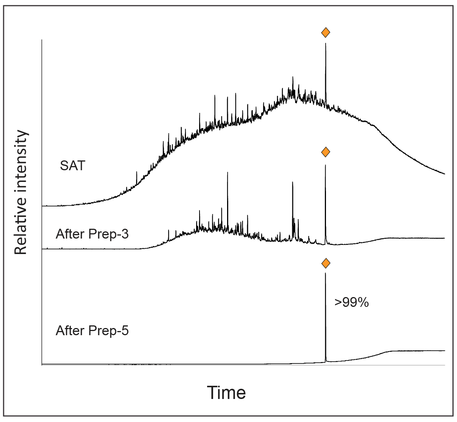

Hydrocarbon degradation: pre-diagenetic, subsurface or environmental
Understanding the biological degradation of petroleum is not only of significance to the oil industry, where the resulting higher viscosity and acidity of hydrocarbon fluids leads to decreased value and hence increased exploration risk, but also to the modern biosphere and society. In our hydrocarbon-fuelled world, oil spills have become common and carry severe environmental consequences. We study various aspects of hydrocarbon degradation in our laboratory, including early diagenetic biological alteration of primary produced biomass through heterotrophic reworking and the more recent biodegradation of subsurface petroleum reserves. In multiple collaborative efforts with other members of the MARUM and the University of Tübingen we look at oil spills and seeps in order to understand how risks and environmental consequences can be mitigated.
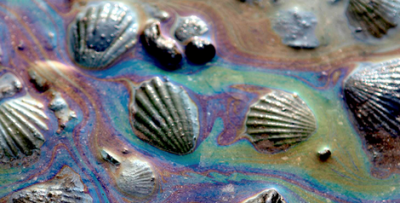
Collaborators:
- Florence Schubotz (MARUM)
- Johan Weijers (Shell)
- Sara Kleindienst (Uni Tübingen)


